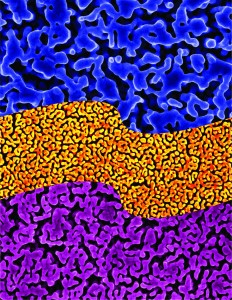Sep 8 2015
A team of researchers from University of California, Davis has proved that nucleic acids can be detected using nanoporous gold, a unique sensor coating material, in a mixture containing other biomolecules, thus beating most of the currently used detectors.
 Nanoporous gold is like a sponge of tiny pores. It could be used to make new devices to detect pathogens. (Erkin Seker , UC Davis)
Nanoporous gold is like a sponge of tiny pores. It could be used to make new devices to detect pathogens. (Erkin Seker , UC Davis)
This novel technique enables sensitive DNA detection in compound biological samples e.g., serum from whole blood. Their findings have been published in two recent papers in Analytical Chemistry.
According to UC Davis researchers, these sponge-like nanoporous gold hold the potential for enabling new devices to detect agents responsible for causing disease in both plants and humans.
“Nanoporous gold can be imagined as a porous metal sponge with pore sizes that are a thousand times smaller than the diameter of a human hair,” said Erkin Seker, assistant professor of electrical and computer engineering at UC Davis and the papers’ senior author. “What happens is the debris in biological samples, such as proteins, is too large to go through those pores, but the fiber-like nucleic acids that we want to detect can actually fit through them. It’s almost like a natural sieve.”
Early identification of disease biomarkers and pathogenic microbes is possible with the swift and sensitive detection of nucleic acids. The existing sensor technologies generally need the nucleic acid to be purified. This would entail performing several steps and require dedicated laboratory equipment, thereby hindering the sensors’ application. The method demonstrated by the UC Davis team decreases the need for purification.
“So now we hope to have largely eliminated the need for extensive sample clean-up, which makes the process conducive to use in the field,” Seker said. The outcome of their research was a swifter and highly efficient procedure, which can be used in numerous settings.
Going forward, the team anticipates that their research will be useful in the progress of mini point-of-care diagnostic systems for clinical and agricultural applications.
“The applications of the sensor are quite broad ranging from detection of plant pathogens to disease biomarkers,” said Seker.
For instance, in human sepsis cases, the illness can be detected early on, thereby preventing any needless treatments as doctors can now establish bacterial contamination much more rapidly than ever before. Similarly, in agriculture, without the occurrence of any symptoms researchers can still detect if pathogens are present.
Pallavi Daggumati, Zimple Matharu, and Ling Wang in the Department of Electrical and Computer Engineering at UC Davis were the other authors of the papers. The UC Davis Research Investments in the Sciences and Engineering (RISE) program, the UC Lab Fees Research Program and the National Science Foundation provided the funding for this research. RISE program promotes interdisciplinary research to find solutions for problems occurring in today’s world.